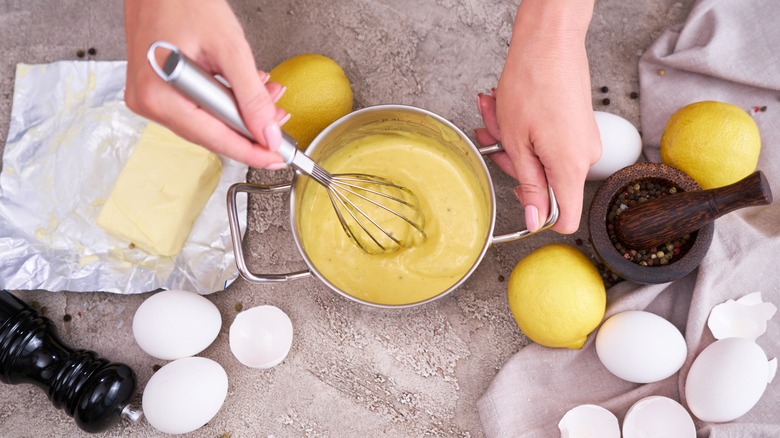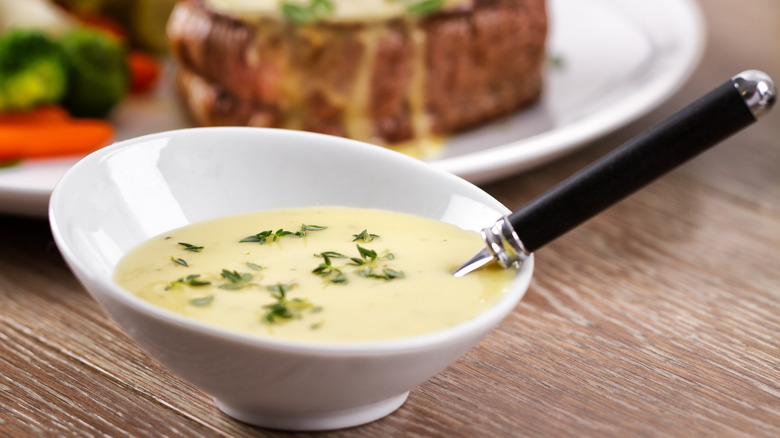The Tool Mary Berry Uses For Smooth Hollandaise Sauce
Whether it's poured over tender asparagus spears, drizzled onto plump juicy scallops, or used to dress a classic eggs Benedict recipe, velvety hollandaise sauce adds a luxurious finishing touch. It can be a slightly intimidating sauce to master, but if you want to get a perfectly smooth result every time, Mary Berry has a top tip: Use a hand whisk.
A basic hollandaise sauce recipe only has a few ingredients — egg yolks, butter, lemon juice or vinegar, and salt — but it's the technique that can prove daunting since there are several ways it can go wrong. That's because hollandaise is made by creating an emulsion, which means that two ingredients that wouldn't ordinarily mix together, such as water and fat, need to be smoothly combined. If they're not, you can end up with a greasy, grainy, or split sauce.
It may involve more time and effort, but Berry's reason for using a hand whisk is simple: It "gives better control over the final texture," she believes (per Mary Berry). While you can make the sauce using an immersion blender or food processor, this can create more of a whipped consistency, where it might become "too thick to pour," warns Berry (via Mary Berry). The hand whisk method is especially useful when you're only making a small amount of sauce, too, which can be tricky or fiddly in a processor.
The dangers of not using a hand whisk to make hollandaise
Mary Berry's hand whisk method has several advantages when it comes to getting great consistency. If you make hollandaise sauce using a blender or food processor, you can't control the temperature in the same way as doing it by hand. Hollandaise must be whisked over a gentle heat to emulsify the ingredients. If the temperature is too high, the eggs begin to scramble – having the water too hot is the most common mistake people make with hollandaise sauce. If it's too low, you can end up with an overly runny sauce. Not only that, but there's a risk the sauce can break or curdle if the temperature isn't right.
Berry's technique involves whisking egg yolks and vinegar or lemon juice in a bowl, then setting it over a pan of simmering water (or a double boiler) while very slowly pouring in the melted butter. You must whisk constantly to fully incorporate the ingredients, and you need to whisk fast to avoid the sauce breaking.
Achieving a smooth texture will take around three to five minutes using a hand whisk, and you'll know when it's ready as the mixture will thicken and become a delicate pale color. Use unsalted butter, so you can better control the salinity according to personal taste, and go for white wine vinegar (or lemon juice) as it won't alter the color of the sauce or make it excessively tart.
More tips to elevate a classic hollandaise sauce
It's best to make hollandaise sauce fresh each time if possible, as it neither keeps nor reheats particularly well. Once you've mastered the basic, rich, and buttery recipe using Mary Berry's hand whisk technique, there are lots of ways to add a new twist to different dishes — whether by altering the texture or by incorporating a wider range of flavors.
To create a lighter, fluffier sauce that also goes further, try transforming the mixture into foaming hollandaise. This essentially involves whisking a couple of egg whites in a clean bowl or container and then folding them into the existing sauce. It's delicious with asparagus, poached eggs, or fish, and is also a neat way to use up the leftover egg whites from making the classic sauce. Alternatively, you could fold freshly whipped cream into a standard hollandaise to turn it into a mousseline.
You can also use traditional hollandaise, which is one of the French mother sauces, as the basis for other tasty variations. While hollandaise and béarnaise are not the same, it's easy to create the latter by using a vinegar reduction infused with shallots, black pepper, and fragrant herbs such as tarragon in place of plain vinegar. The aromatic, anise-like flavor pairs perfectly with steak or grilled chicken. Add orange juice and zest to transform hollandaise into a Maltaise sauce, or simply add mustard for a sweeter, spicier, and tangier result.



